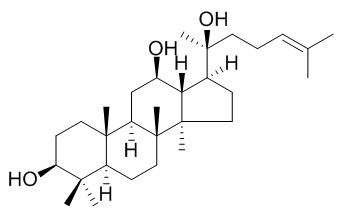(20S)-Protopanaxdiol
20(S)-Protopanaxdiol may be a potential new P-gp inhibitor for cancer treatment, it may induce the apoptosis via the down-regulation of Bcl-2 protein and the up-regulation of γH2Ax protein expression; it may inhibit the proliferation of Siha cells via the up-regulating the expressions of p53, p21, and autophagy related gene Beclin 1and MAP1-LC3, and down-regulating the expression of cyclin-E.
Inquire / Order:
manager@chemfaces.com
Technical Inquiries:
service@chemfaces.com
Tel:
+86-27-84237783
Fax:
+86-27-84254680
Address:
1 Building, No. 83, CheCheng Rd., Wuhan Economic and Technological Development Zone, Wuhan, Hubei 430056, PRC
Providing storage is as stated on the product vial and the vial is kept tightly sealed, the product can be stored for up to
24 months(2-8C).
Wherever possible, you should prepare and use solutions on the same day. However, if you need to make up stock solutions in advance, we recommend that you store the solution as aliquots in tightly sealed vials at -20C. Generally, these will be useable for up to two weeks. Before use, and prior to opening the vial we recommend that you allow your product to equilibrate to room temperature for at least 1 hour.
Need more advice on solubility, usage and handling? Please email to: service@chemfaces.com
The packaging of the product may have turned upside down during transportation, resulting in the natural compounds adhering to the neck or cap of the vial. take the vial out of its packaging and gently shake to let the compounds fall to the bottom of the vial. for liquid products, centrifuge at 200-500 RPM to gather the liquid at the bottom of the vial. try to avoid loss or contamination during handling.
Plant Physiol Biochem.2019, 144:355-364
Nutrients.2019, 12(1):E40
J Adv Res.2021, 35:245-257.
ACS Nano.2018, 12(4):3385-3396
Biomolecules.2024, 14(4):451.
Mol Neurobiol.2023, 60(12):7196-7207.
Data Science for Genomics2023, 107-128.
Biochem Biophys Res Commun.2020, 522(4):1052-1058
Molecules.2024, 29(24):5983.
Int J Mol Sci.2023, 25(1):283.
Related and Featured Products
Journal of Jilin University, 2013, 39(05):909-12.
Inhibitory effect of 20(s)-protopanaxdiol on proliferation of Siha cells in vitro and its mechanism.[Reference:
WebLink]
To observe the effect of (20S)-Protopanaxdiol(PPD)on the cell cycle of Siha cells in vitro and to detect the transcription and expressions of p53,p21and cyclin-E,and to clarify the mechanism of its inhibitory effect on proliferation of Siha cells.
METHODS AND RESULTS:
The Siha cells cultivated in vitro were treated with alcohol(negative control group)and 20μg·L-1 PPD(PPD group),respectively.The cell cycle was detected by FCM 48h after treatment.The mRNA and protein expressions of p53,p21and cyclin-E in Siha cells were analyzed by Real time PCR and Western blotting. Compared with negative control group,after treated with 20μg·L-1 PPD for 48h,the ratio of Siha cells at G0 /G1 phase was increased(P0.01),the blockage of G1 phase was obviously enhanced;the transcription and protein expressions of p53and p21were up-regulated(P0.01);while the transcription and expression of cyclin-E were significantly decreased(P0.01).
CONCLUSIONS:
PPD may inhibit the proliferation of Siha cells,and its mechanism may be related to up-regulating the expressions of p53and p21and down-regulating the expression of cyclin-E.
Planta Med. 2009 Aug;75(10):1124-8.
20S-protopanaxadiol inhibits P-glycoprotein in multidrug resistant cancer cells.[Pubmed:
19291609]
One of the major causes for cancer cells to resist current chemotherapy is attributed to the over-expression of P-glycoprotein (P-gp), resulting in insufficient drug delivery to the tumor sites.
METHODS AND RESULTS:
Protopanaxadiol ginsenosides Rg3 and Rh2 are known to induce apoptosis and significantly enhance the tumor inhibitory effects of chemotherapeutics in a synergistic fashion. One of the possible mechanisms is by blocking P-gp activity. The final deglycosylation metabolite of protopanaxadiols (PPDs) IN VIVO is (20S)-Protopanaxdiol (aglycone PPD, aPPD), which has also shown anticancer activity and synergy with chemotherapy drugs. In the present study, P-gp over-expressing cancer cells were utilized to test whether (20S)-Protopanaxdiol also inhibits P-gp activity. We found that (20S)-Protopanaxdiol caused similar cytotoxicity in P388adr cells as their parental non-MDR cells, suggesting that (20S)-Protopanaxdiol may not be a substrate of P-gp. On the other hand, the calcein AM efflux assay showed that (20S)-Protopanaxdiol was able to inhibit P-gp activity as potently as verapamil on MDR cells.
The blockage of P-gp activity was highly reversible as wash-out of (20S)-Protopanaxdiol resulted in an immediate recovery of P-gp activity. Unlike verapamil, (20S)-Protopanaxdiol did not affect ATPase activity of P-gp suggesting a different mechanism of action.
CONCLUSIONS:
The above results indicate that (20S)-Protopanaxdiol , unlike its precursor ginsenosides Rg3 and Rh2, is not a substrate of P-gp. It is also the first time that (20S)-Protopanaxdiol has showed a reversible nature of its P-gp inhibition. In addition to its pro-apoptotic nature, (20S)-Protopanaxdiol may be a potential new P-gp inhibitor for cancer treatment.
Journal of Jilin University Medicine Edition, 2012, 38(3):482-5.
Inductive effect of (20s)-proto-panaxdiol on apoptosis of human prostate cancer PC3 cells cultivated in vitro and its mechanism[Reference:
WebLink]
To study the effect of (20S)-Protopanaxdiol (PPD) on apoptosis of human prostate cancer PC3 cells cultivated in vitro, and to clarify the mechanism of its anticancer action.
METHODS AND RESULTS:
The PC3 cells cultivated in vitro were divided into control, and 20, 30, 40 μmol·L -1 PPD groups. The morphological changes of PC3 cells were observed under optical microscope after treated with PPD for 48 h. The proliferation inhibition of PC3 cells was detected by MTT method. The apoptosis of PC3 cells was detected by AO/EB staining and the expressions of Bax, Bcl-2 and γH2Ax proteins were analyzed by Western blotting. After treated with different doses of PPD, the PC3 cells were round, recovery, and broken. AO/EB staining found that the cells presented yellow-green. The inhibitory rates of proliferation of PC3 cells in various groups were increased compared with control group(P<0.05). The expression of Bcl-2 protein was down-regulated(P<0.05), the expression of Bax protein didn't change significantly, and the expression of γH2Ax protein was up-regulated (P < 0.05).
CONCLUSIONS:
PPD may induce the apoptosis of PC3 cells, and its mechanism may be related to the down-regulation of Bcl-2 protein and the up-regulation of γH2Ax protein expression.



